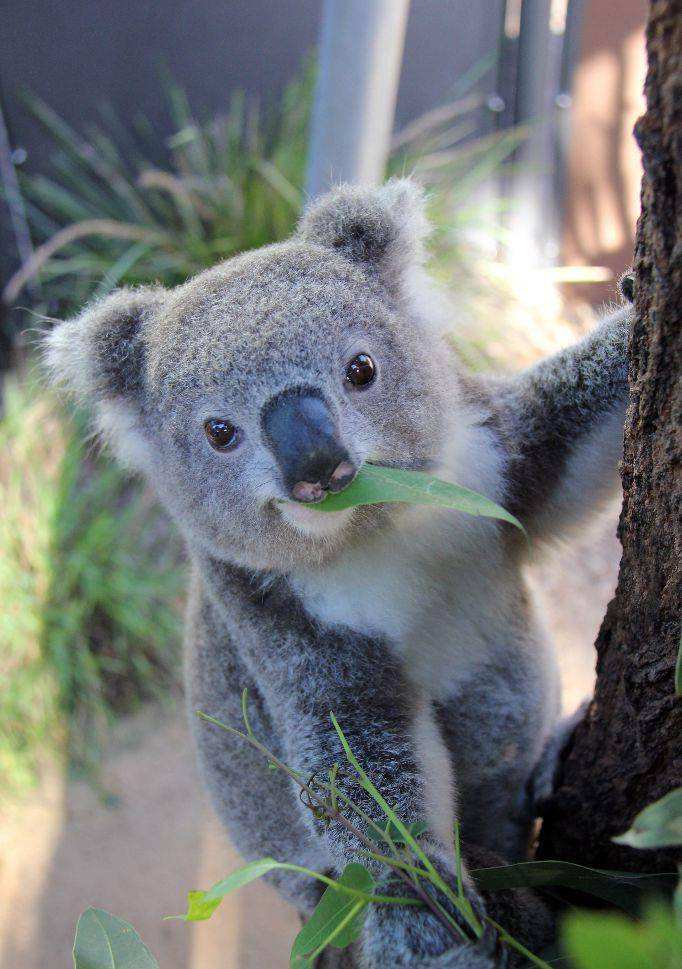Koala
IUCN
LCBasic Information
Scientific classification
- name:Koala
- Scientific Name:Phascolarctos cinereus
- Outline:Rodents
- Family:Mammalia Marsupialia Diprotodontia Phascolarctidae Phascolarctos
Vital signs
- length:70-80 cm
- Weight:10 KG
- lifetime:10-20 Year
Feature
Australia's national treasure, the largest arboreal marsupial.
Distribution and Habitat
Koalas are mainly distributed in Australia (New South Wales, Queensland, South Australia, Victoria).
Appearance
Koalas are obese, with thick, shaggy fur and no tail. Koalas have a relatively small brain, which may also be an adaptation to their low-energy diet. Adult koalas are about 70-80 cm long and weigh about 10 kg. Their bodies are light gray to light yellow, with a relatively bright color around the abdomen. Their noses are bald, large and round, their heads are round, and the fur on their ears is very fluffy. Their forelimbs have very strong claws and are good at climbing.
Males are 50% larger than females. The female's pouch is tightened by a sphincter to prevent the cubs from falling out. Koalas have the most effective insulating hair, while the fur on their abdomens can reflect solar radiation. Koalas' curved, sharp claws are well suited for climbing trees. The large front paws have two opposing fingers (the first and second, as opposed to the other three), allowing them to grasp small branches. On the hind paws, the second and third fingers are fused, which is a typical f
Details
Australia is the kingdom of marsupials, and the koala is the most precious one. It looks like a velvet teddy bear, with a fat body covered with fluffy light gray or light yellow fur, no tail, a big head, bright eyes, two large semicircular ears standing upright on both sides of the head, long fur covering the auricle, short fur on the face, and a smooth black nose, which is very cute. It also has a nice name, "koala". ”

Koalas have long been ranked among the world's top ten cute pets, and are loved by people from all over the world, especially "koala fans". Koalas have a cute face like a teddy bear, innocent eyes and an unusually docile temperament. In order to grasp branches more powerfully, koalas have also evolved two thumbs, and the five-finger grip mode has evolved from "1-4" to "2-3", making them more unique in appearance. The eucalyptus leaves that koalas eat contain eucalyptol and water anise terpenes, so they always exude a rich eucalyptus fragrance.
As an arboreal animal, the koala sitting on a tree branch and sleeping soundly is as naive as a sleeping baby, and as experienced and profound as a philosopher thinking about the "life" of a koala. Its furry ears fluttering when it scratches itself in various ways is even more adorable. Even the loser in a fight sitting on the ground and crying like a naughty little kid is particularly lovable. When the cub comes down from the tree, the mother koala carefully stretches out her hands ready to hold it at any time, which makes people see the great maternal love regardless of species. The most intoxicating thing is that tourists going to Australia also have a "princess hug" interactive session. In Queensland, Western Australia and South Australia, it is legal to "hug the baby". This interaction is unforgettable for many people.
It was listed as vulnerable in 2016, and its population is declining. One of the biggest man-made threats to koalas is habitat destruction and fragmentation.
The endangerment of koalas indicates that a unique mammal species may become extinct. Although marsupials are also distributed in the Americas, koalas only live in Australia. Therefore, Australian koalas cannot find "cousins" anywhere on the earth. Once extinct, it will cause an imbalance in the food chain and the permanent disappearance of the gene pool and biological resource potential value of the species. Preventing species extinction has become a global urgent task, not to mention a unique species like koalas.








